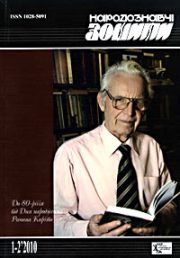The Ethnology Notebooks. 2019, № 6 (150), 1525—1535
УДК: 7.035(450+477)
DOI https://doi.org/10.15407/nz2019.06.1525
THE INFLUENCE OF THE ART OF ITALIAN PRERENAISSANCE ON THE WORK OF MYKHAILO BOYCHUK AND HIS STUDENTS
KUSHNIRUK Nataliia
ORCID ID: https://orcid.org/0000-0002-8721-0865
PhD student of the Department of Religious Studies and Theology
of National University of Ostroh Academy,
Lecturer of the Department of Document Studies and Information Activities
of National University of Ostroh Academy,
2, Seminar Str., 35800, Jail, Rivne area, Ukraine
Contacts: е-mail: nataliia.bendiuk@oa.edu.ua
Abstract. The article is devoted to the problem of the influence of the Italian art of XIV — early XV century on art of Mykhailo Boichuk and his students. Thanks to the support of Metropolitan Andrey Sheptytsky he got an opportunity to study at the major art centers in Europe during the formation of avant‑garde directions. He wanted to create a new national Ukrainian style based on the creative inheritance of previous epochs. There are a lot of researches about the influences of Byzantine, Egyptian, Assyrian, national Ukrainian art on the formation of «boichukism». However, there are almost no researches about the impact of the early Italian Renaissance on the art of Mykhailo Boichuk. It determines the aim of the article. The purpose of the research is to distinguish influences of the Prerenaissance on the formation of esthetic basis of art and pedagogical principles of Mykhailo Boichuk.
The object of the research is the connection between art of Mykhailo Boichuk and his students and Italian Prerenaissance. The subject is specific features of artistic techniques of Italian masters of XIV — early XV century in the works of Mykhailo Boichuk and his students.
Traveling to Italy of Mykhailo Boichuk, Sophia Nalepinska and Mykola Kasperovych was a very important point for studying of the Italian art of the Prerenaissance. There they were able to clearly understand the works of Giotto, Duccio, Lorencetti, Martini, Masaccio, Fra Angelico, Ucello and others.
The methodological basis of the article is such methods as iconographic, method of formal-stylistic and artistic analysis, historical system approach.
Time and territorial boundaries include 1898—1937 specifically studying of Mykhailo Boichuk in Vienna, Krakow, Munich, Paris, traveling around Italy and work in Lviv and Kyiv.
Acording to the research the tasks were set: to analyze Mykhailo Boychuk’s acquaintance with the works of Italian artists of Prerenaissance; explore the use of basic compositional techniques, rhythms, shapes and colors, painting techniques of Italian masters of trecento and early quattrocento by Mykhailo Boichuk in his art works; to explore the use of the above methods by Mykhailo Boichuk in his pedagogical activity and to distinguish their use by the students in their works.
Keywords: Prerenaissance, Mykhailo Boichuk, artist, monumental art, boichukism, trecento, quattrocento.
Received 24.10.2019
REFERENCES:
Kravchenko, Ya. (2009). In the footsteps of one photo. (The Ukrainian group «Renovation Byzantine» in Paris. An attempt to personalize the portraits of Mykhailo Boichuk 1909—1910). Artaniia, 4 (Vol. 17, pp. 54—58). Kyiv: «Sofiia-A» [in Ukrainian].
Kravchenko, Ya. (2016). Creating a workshop of «icon and fresco» of Ukrainian Academy of Art during the period of Ukrainian statehood (1917—1919) on the basis of «Paris» and «Lviv» experiments of «Neo‑Byzantinism» by Mykhailo Boichuk. Visnyk LNAM (Issue 30, pp. 126—153). Lviv [in Ukrainian].
Bilokin, S. In Lviv. Mykhajlo Bojchuk and his school. Retrieved from: https://www.s-bilokin.name/Culture/Bojchuk/Lviv.html (Last accessed: 5.09.2019) [in Ukrainian].
Bilokin, S. In Paris. Mykhajlo Bojchuk and his school. Retrieved from: https://www.s-bilokin.name/Culture/Bojchuk/Paris.html (Last accessed: 5.09.2019) [in Ukrainian].
Horbachov, D. (1999). Memoirs of Hanna Pecharkovska about Boichuk and boichukists. Kyivska starovyna, 6, 133—150). Kyiv [in Ukrainian].
Sokoliuk, L. (2014). Mykhajlo Bojchuk and his school. Kharkiv [in Ukrainian].
Slipko-Moskaltsev, O. (1930). Mykhajlo Bojchuk. Kharkiv: Rukh [in Ukrainian].
Mudrak, M. (2018). Nova Heneratsiia and artistic modernism in Ukraine. Kyiv: Rodovid [in Ukrainian].
Susak, V. (2010). The Ukrainian artists of Paris 1900—1939. Kyiv: Rodovid [in Ukrainian].
Ripko, O. (1996). In search of the lost past: a retrospective of Lviv art culture of the XX century. Lviv: Kameniar [in Ukrainian].
Susak, V. (Ed.) (2010). Mykhajlo Bojchuk. Al’bom-kataloh zberezhenykh tvoriv. Kyiv: Majsternia Knyhy [in Ukrainian].
Beniakh, N. (2018). Lviv period of Mykhajlo Bojchuk’s creation 1910—1914. (PhD dissertation). Lviv: LNAM [in Ukrainian].
Kovalchuk, O. (2003). History of the Fine Art Faculty of National Academy of Fine Arts and Architecture of Ukraine, and its role in the national painting school formation in 1917—1941. (PhD dissertation) Kyiv: NAOMA [in Ukrainian].






